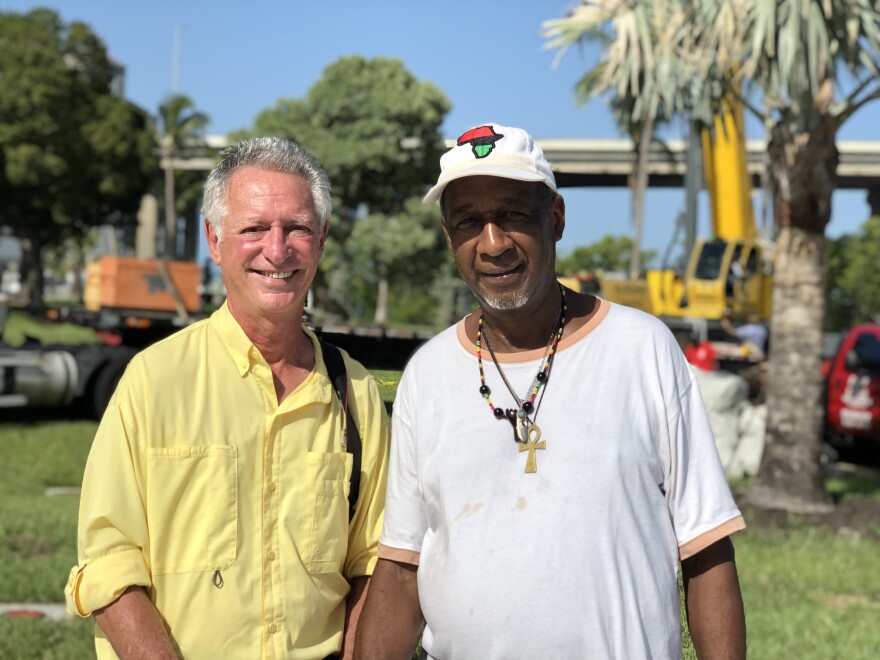Last Friday, a 66,000-pound bronze statue was rotated 180 degrees in Fort Myers' Centennial Park. It stands roughly 9-feet tall, and memorializes a sergeant in the United States Colored Troops (USCT) 2nd Regiment. It’s framed in between two white walls that symbolize freedom. This is it's second time to be moved.
The memorial is known as “Clayton,” because it is made out of a ton of clay then cast in bronze. His original home was on the eastern edge of Centennial park facing the city park. But earlier this year it was moved to accommodate space for the new Caloosa Sound Amphitheater.
Unfortunately, when the monument was placed in its current spot several hundred feet away, the statue of the soldier was turned with its back to Centennial Park and its face toward the river, obscured from public view.
Community members found the placement disrespectful.
David Kelly has been living in Southwest Florida for almost 20 years. He often comes to Centennial Park to fish. Kelly says where Clayton was moved earlier this year seemed like an afterthought.
“There’s nothing over here," said Kelly. "What’s he doing, guarding the river? He should be facing the road so everybody can see the guy. By them having him backwards it’s like defacing him to me. He should be facing the road."

Lodovic Kimble is a local activist and former President of Lee County NAACP. He shares a sentiment similar to Kelly’s.
“Somebody was insensitive to set that monument there and not think how the African American community was going to react,” said Kimble.
Kimble’s also a retired Florida Gulf Coast University Psychology Professor, and one of his former students is Fort Myers Mayor Kevin Anderson.
“I called Kevin, you want me picketing on our steps? He says what? I said Kevin, they did something stupid today. They took this monument and got Clayton looking into the woods. We need that turned around.”

What Clayton represents in the community is far larger than the stature of the gilded statue. On February 20, 1865, Confederate soldiers attacked Fort Myers in an attempt to steal cattle and destroy the military fort.
Tom Hall with the Fort Myers Public Art Committee explains that Fort Myers was a Union outpost in the Civil War. The USCT alongside Union forces thwarted Confederate attempts to steal roughly 4,000 head of cattle and burn the wooden fort. Hall says without that structure; the City of Fort Myers might not have existed at all.

“If they had succeeded, there would have been no wood, there would have been no reason for settlers to come in the aftermath of the Civil War.”
Without the leftover raw materials, Hall says Fort Myers founder Manuel Gonzalez would have likely passed over the area in 1866. Gonzales and his settlers used the remnants of the fort to build the town of Fort Myers.

“In all likelihood, downtown Fort Myers would probably be in Punta Rassa today if the Confederate attack had succeeded.”
Throughout the Civil War, the USCT is credited to have freed and enlisted over 1,000 enslaved people in Florida.
The USCT 2nd Regiment Monument in Centennial Park was dedicated on Veteran’s Day in 1998, and in 2000 the City of Fort Myers commissioned prominent, local sculptor D.J. Wilkins to create a tribute to the African Americans who fought and died to protect Fort Myers. Thus Clayton was born.
Today in Centennial Park, second time’s the charm, as Clayton is excavated, lifted and turned with the help of a crane to face the park once again.
Kelly applauds this effort.
“They’re doing the right thing," said Kelly. "It should have been that way from the start,” said Kelly.

Kimble notes that the recognition of the City’s oversight and quick action to reposition the monument is the right decision.
“The City responded in the most positive way," said Kimble. "Plus, Kevin also agreed immediately that that was wrong. The Art Committee, everybody agreed that this was turned around, and the Mayor said immediately, ‘we will turn it around.’ And that's what we’re doing today.”
After two moves, the Clayton monument will need some repairs, including repainting the walls and reinstalling two accompanying granite plaques. One explains the significance of the USCT during the Battle of Fort Myers, the other displays a poem by the monument’s sculptor D.J. Wilkins titled, “In Freedom Cover Me.”

Centennial Park is at 2000 W First St in downtown Fort Myers.












